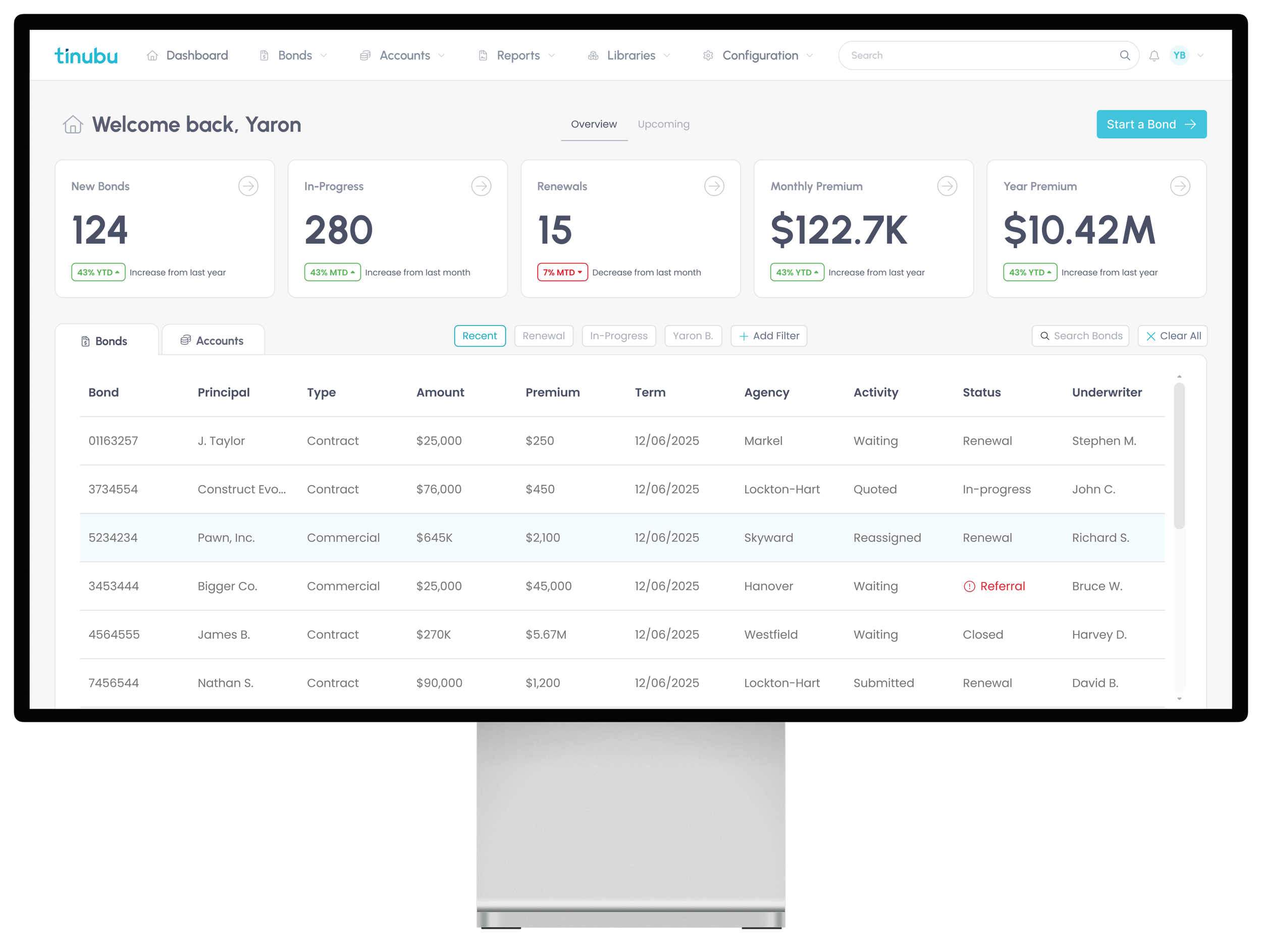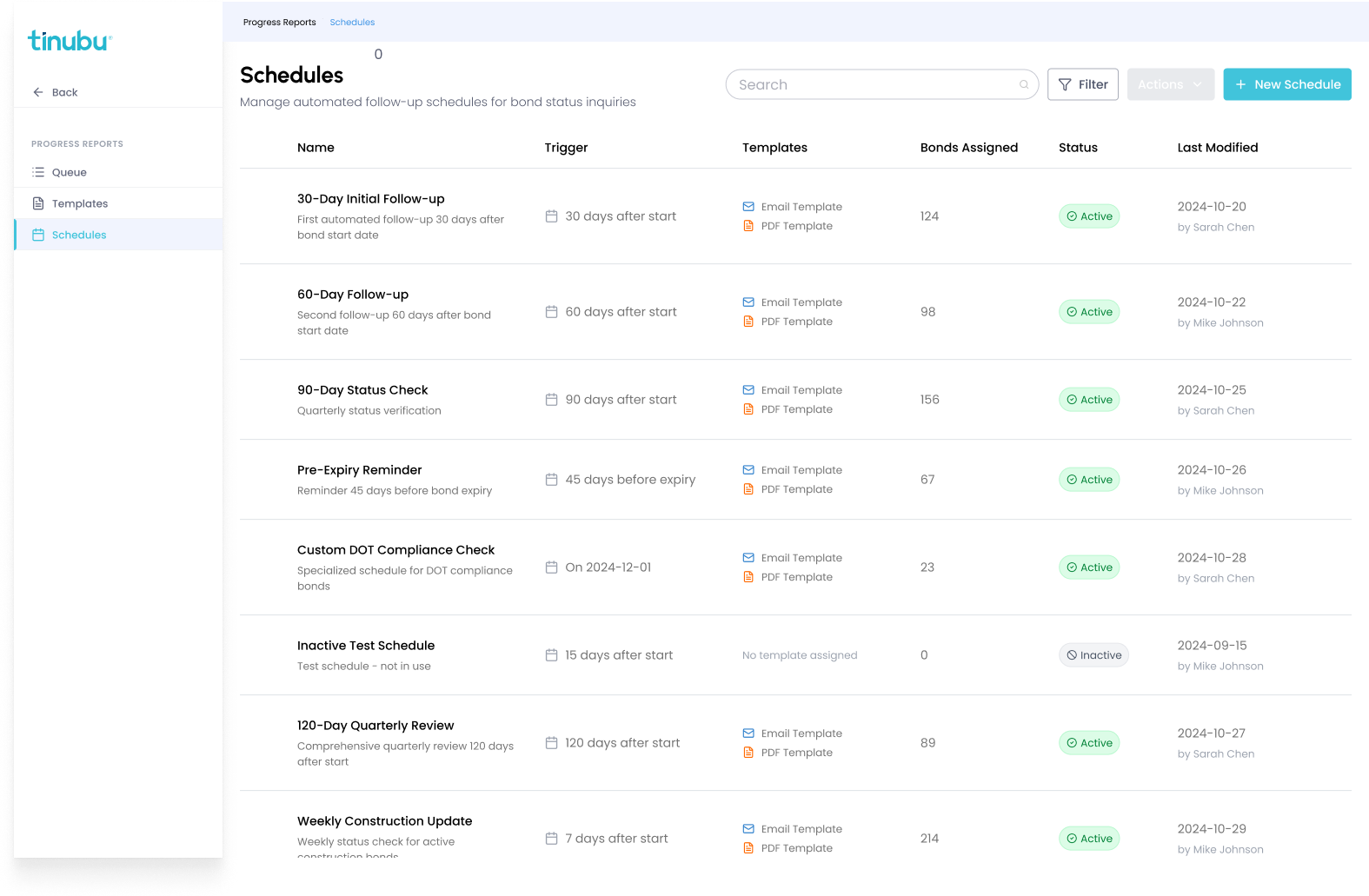Modernizing a legacy platform
Tinubu Surety
Enterprise SaaS, Complex Workflow Design, InsurTech (B2B)
Surety bonding is a complex and highly regulated ecosystem that depends on seamless collaboration between brokers, agents, and underwriters. Each participant relies on accurate data, clear workflows, and intuitive tools to manage risk and ensure compliance. Despite its critical role in the industry, Tinubu’s platform faced challenges common to legacy systems: outdated interfaces, fragmented workflows, and steep learning curves that slowed adoption.
As a leader in the surety space, Tinubu recognized the need for a comprehensive UX/UI overhaul. The goal was to modernize the platform, streamline user workflows, and create an experience that was not only efficient but also intuitive and engaging. By focusing on the needs of all stakeholders—brokers, agents, and underwriters—the redesign aimed to reduce friction, improve task completion, and drive overall platform adoption.
Through a human-centered, data-informed design approach, Tinubu sought to transform its platform into a modern, high-performance tool that empowers users to work smarter, faster, and more confidently in a complex industry.
My Role
Product Design
Interactive Design
UX Architecture
UX Research
Leadership
Platforms
Web
As the Principal Designer, I led the full redesign of Tinubu’s platform, introducing design thinking methodologies and guiding the project from initial research through final delivery. I worked closely with cross-functional teams—including product managers, engineers, and business stakeholders—to ensure alignment on both business goals and user needs.
Business Challenge
Tinubu Surety’s legacy platform faced significant challenges that hindered efficiency and user satisfaction. Brokers, underwriters, and internal teams struggled with outdated interfaces, cumbersome workflows, and inconsistent interactions across the system. These limitations led to long onboarding times, frequent errors in submissions, and overall frustration for users.
The challenge was clear: redesign the platform to address these pain points, modernize usability, and create a seamless experience that aligned with the needs of all stakeholders. Our goal was not just to refresh the interface, but to reimagine workflows, streamline complex processes, and deliver a platform that empowered users to work more efficiently and confidently. By combining human-centered research, data-driven insights, and iterative design, we set out to transform Tinubu Surety into a modern, high-performing solution that would increase adoption, reduce errors, and elevate the overall user experience.
Research Methods
User Interviews – Conducted in-depth conversations with underwriters, brokers, and internal teams to uncover real-world pain points, workflow bottlenecks, and unmet needs. These interviews revealed both overt frustrations and subtle challenges that users had adapted to over time, providing rich qualitative insights to guide the redesign.
Usability Testing – Observed how users interacted with the legacy system through task-based testing and scenario walkthroughs. This process highlighted inefficiencies, confusing navigation patterns, and areas where users struggled to complete critical tasks, helping us identify high-priority improvements for the new platform.
Competitive Analysis – Evaluated industry-standard solutions and platforms to benchmark best practices, understand emerging trends, and identify opportunities to differentiate Tinubu. By analyzing competitors’ workflows, features, and user experiences, we gained a clear picture of what worked well in the market and where Tinubu could excel.
Data Analysis – Reviewed quantitative platform usage data to determine which features were most frequently accessed, which actions had high error rates, and where user engagement dropped off. This analysis ensured that our redesign focused on enhancing the tools and workflows that mattered most to users, while eliminating friction in low-value areas.
Legacy Dashboard
Modernized Dashboard (v2)
Failed Iterations & Key Learnings
Navigation Overhaul – Our first redesign iteration introduced a sidebar-based navigation intended to centralize access to all platform features. However, usability testing revealed that users found the layout cluttered and overwhelming, making it harder to quickly locate key tasks. Based on this feedback, we pivoted to a simplified, task-oriented navigation structure that prioritized the most common workflows. This change significantly improved task completion speed and overall user satisfaction.
Form Redesign – Early iterations featured a multi-step form for entering bond information, which was designed to guide users through the process systematically. During usability sessions, we discovered that frequent users were slowed down by unnecessary steps and repetitive inputs. To address this, we introduced quick-entry options, smart defaults, and inline validation. These improvements allowed users to complete forms faster while reducing errors, particularly for repetitive tasks.
Dashboard Insights – Initially, we proposed a highly detailed dashboard displaying extensive underwriting data and metrics. While comprehensive, testing revealed that users felt overwhelmed by the volume of information and struggled to focus on critical tasks. We refined the design to present only the most relevant underwriting data upfront, with contextual drill-downs for additional details. This approach improved situational awareness and allowed users to make faster, more confident decisions.
Key Learnings – These iterations reinforced the importance of continuous user testing, rapid prototyping, and staying flexible in our design approach. By observing real user behavior and incorporating feedback at every stage, we were able to pivot away from assumptions and develop solutions that truly met user needs, balancing efficiency, clarity, and usability across the platform.
Modernized Dashboard (v3)
Metrics & Outcomes
📉 40% Reduction in Bond Submission Time – By streamlining workflows, simplifying forms, and redesigning the platform’s navigation, users were able to complete bond submissions almost twice as fast. This reduction not only saved valuable time for brokers and underwriters but also increased overall throughput and productivity across the platform.
💡 Increased Broker Adoption – The improved usability and clarity of the redesigned interface led to a 30% rise in active broker users within the first three months of launch. By aligning the platform more closely with user needs, we encouraged consistent engagement and demonstrated immediate value to the user base.
⏳ 50% Faster Onboarding – New users were able to get up to speed significantly faster thanks to a more intuitive interface, contextual guidance, and updated documentation. Onboarding time was cut in half, enabling brokers and internal teams to start using the platform confidently with minimal friction.
🔍 25% Reduction in Submission Errors – Clearer forms, inline validations, and smarter defaults helped reduce errors during bond submissions by a quarter. This improvement not only enhanced user confidence but also increased operational efficiency, reduced rework, and strengthened compliance across workflows.
Overall Impact – By combining a human-centered design approach with data-informed insights, the redesign transformed the platform into a faster, more intuitive, and highly reliable tool. Users now experience smoother workflows, fewer errors, and greater satisfaction, while Tinubu benefits from increased adoption, improved efficiency, and measurable business outcomes.
Key Takeaways
User-Centered Research – Engaging directly with underwriters, brokers, and internal teams was essential in uncovering critical pain points, workflow inefficiencies, and areas of frustration within the legacy system. By grounding design decisions in real user needs, we ensured that the solutions we developed addressed actual problems rather than assumptions.
Iterative Testing & Learning – Continuous prototyping, usability testing, and feedback loops allowed us to refine the platform at every stage. Failed iterations became opportunities to learn, guiding adjustments to navigation, forms, and dashboards. This iterative approach helped us create a design that was intuitive, efficient, and aligned with user expectations.
Data-Driven Decisions – By analyzing platform usage data alongside qualitative research insights, we prioritized improvements that had the greatest impact on user workflows. This ensured that our design efforts focused on enhancing features that mattered most, reducing errors, and streamlining complex processes.
Strategic Business Impact – Beyond improving usability, the redesign strengthened Tinubu Surety’s competitive position in the industry. The modernized platform not only increased adoption and user satisfaction but also enhanced operational efficiency, solidifying the company as a forward-thinking leader in the surety space.
Overall Insight – Combining human-centered design, iterative refinement, and data-informed decision-making demonstrates how thoughtful UX/UI design can drive measurable business results while creating meaningful, lasting value for users.




























